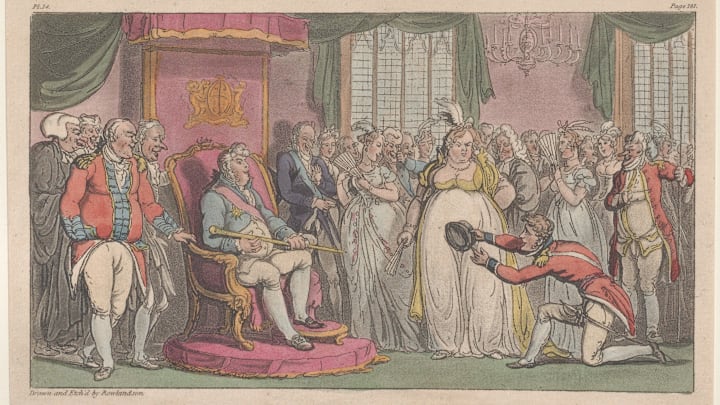The British nursery rhyme “Georgie Porgie” tells of a plump child who kisses girls and runs away from boys. On the surface, the verse seems to be about the antics of a naughty kid, but as with many nursery rhymes, there are rumors that the simple words have a deeper hidden meaning.
Before chasing down the facts and theories about “Georgie Porgie,” here’s a quick reminder of the lyrics that are typically sung today:
Georgie Porgie, pudding and pie,
Kissed the girls and made them cry;
When the boys came out to play,
Georgie Porgie ran away.
The Kiss and Cry Corner
The oldest known written record of “Georgie Porgie” was printed in 1841 in The Kentish Coronal, but it features a few differences to the modern lyrics:
Georgy Peorgy, pudding and pie,
Kissed the girls and made ‘em cry;
When the girls came out to play,
Georgy Peorgy ran away.
Along with the variation in the spelling of the titular character’s name, the third line has it that girls—rather than boys—come out to play. The rhyme is described as the only surviving “fragment of an old ballad, or lyric poem,” indicating that it predates the collection’s publication in the 1840s. Just a few years later, in 1844, James Halliwell-Phillipps noted a different version of the tune in the third edition of The Nursery Rhymes of England:
Rowley Poley, pudding and pie,
Kissed the girls and made them cry;
When the girls begin to cry,
Rowley Poley runs away.
Both Georgie Porgie and Roly Poly (spelled “Rowley Poley” above) are names associated with fuller figures, but which moniker was first used in the oral tradition of the rhyme is unknown. The lyrics “pudding and pie” are also changed in some later versions of the song. In 1887, “picklety pie” is recorded as the dialect phrase sung in South Cheshire, and in 1904, American psychologist Amy Tanner used “pumpkin pie” in The Child: His Thinking, Feeling, and Doing.
The detail of boys coming out to play first appears in print in 1882 in Haileybury Verses, but this take on the rhyme is rather different. Georgie Porgie is “In the remove, / For fagging thinks / He’ll show no love,” with fagging referring to the British private school practice of younger schoolboys doing tasks for older schoolboys. The version that we sing today crops up just two years later, in an 1884 picture book.
The Royal Treatment
There have been a fair few contenders for the identity of the real person Georgie Porgie represents—all are either royals or have connections to royalty. Here are the top three theories.
Many aspects of the life of George IV—who served as prince regent from 1811 to 1820 and ruled the UK as king from 1820 to 1830—seem to fit the lyrics of the rhyme. George’s heavy weight was the subject of ridicule throughout his reign, which may explain the “pudding and pie” reference. He also had several mistresses, the most prominent being Maria Fitzherbert, whom he illegally married in 1785. Ten years later, he legally married Princess Caroline of Brunswick from Germany, but the couple hated each other, with George not even letting her attend his coronation. His playboy antics may be the inspiration behind the “kissed the girls and made them cry” line.
Another possibility is George Villiers, 1st Duke of Buckingham—the favorite, a.k.a. intimate companion, of King James VI and I. Unlike George IV, Buckingham had a slim build, but his love life was just as infamous. James publicly lavished attention on Buckingham, leading to rumors about the pair getting frisky in the bedroom. While at the French court in 1625, Buckingham—who was married to Katherine Manners—also scandalously revealed his lust for Anne of Austria, queen of France.
Alternatively, folklorists Iona and Peter Opie note that “popular tradition insists ‘Charles II’” is Georgie Porgie. Charles ruled during the mid-1600s and, like George IV, was notorious for his womanizing ways, but, like Buckingham, he wasn’t overweight. Charles and his queen, Catherine of Braganza, had no children together. Nonetheless, Charles was quite the Casanova, having around 14 mistresses and at least 11 illegitimate children.
Read More About Nursery Rhymes:
